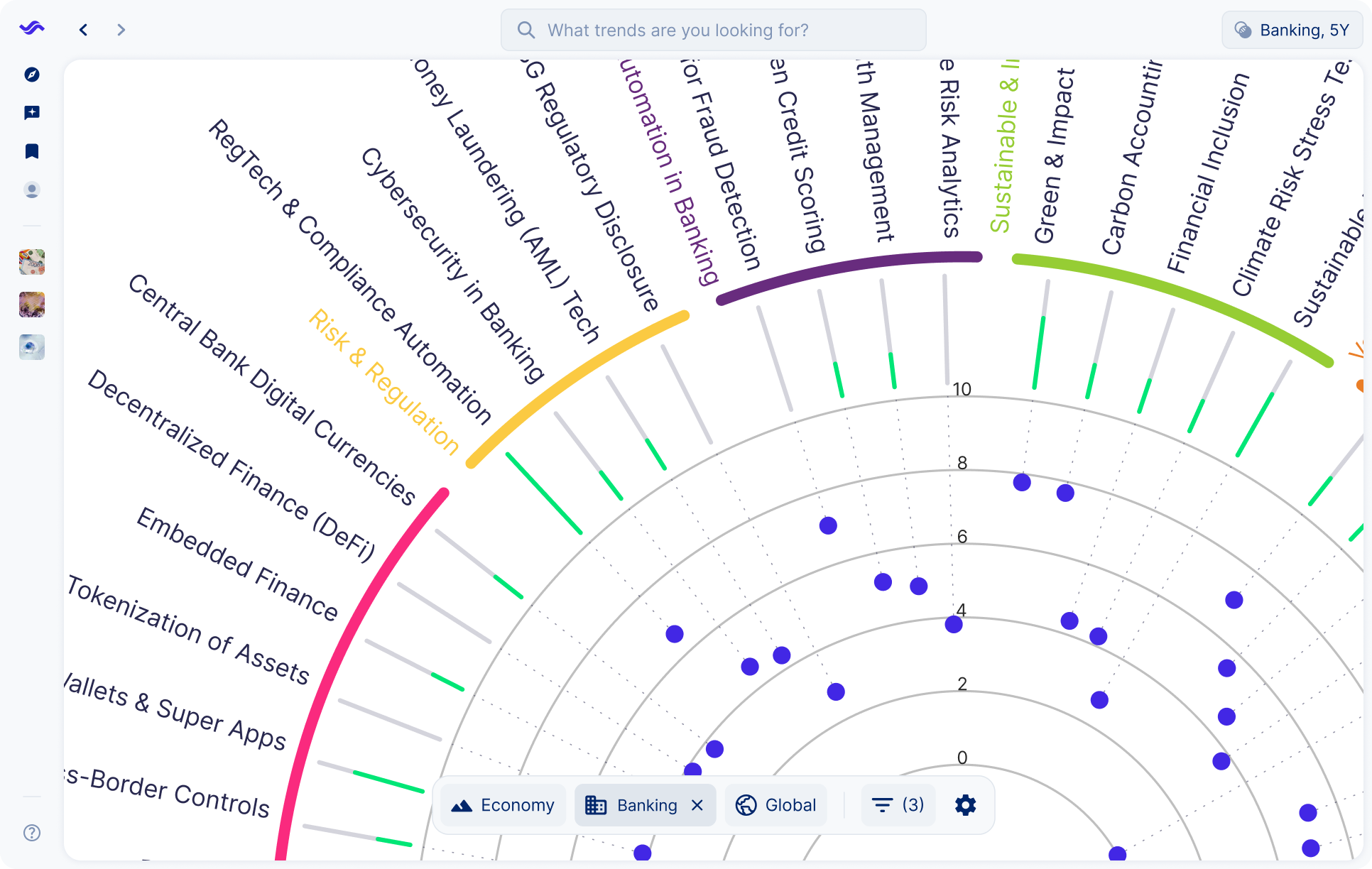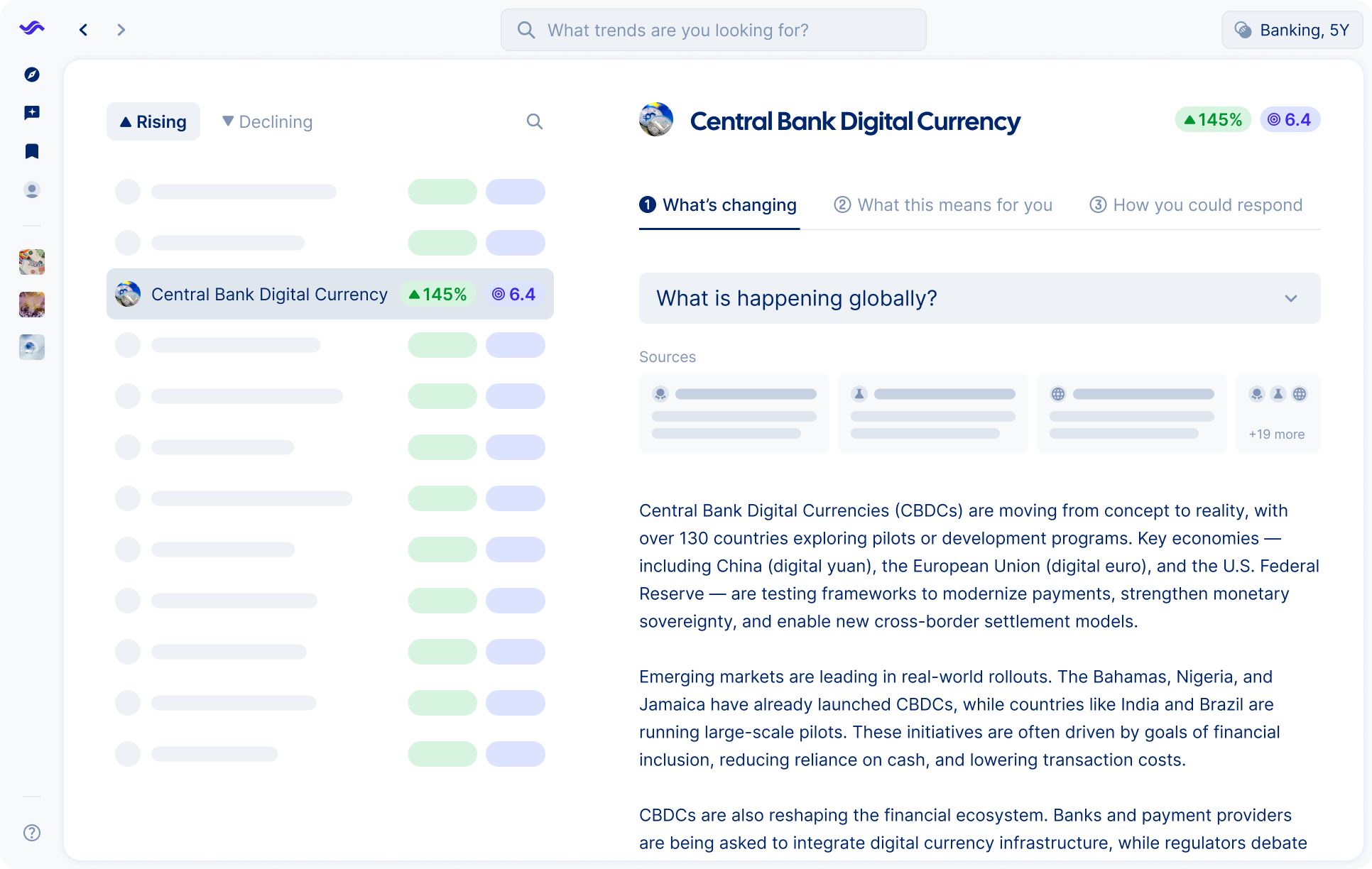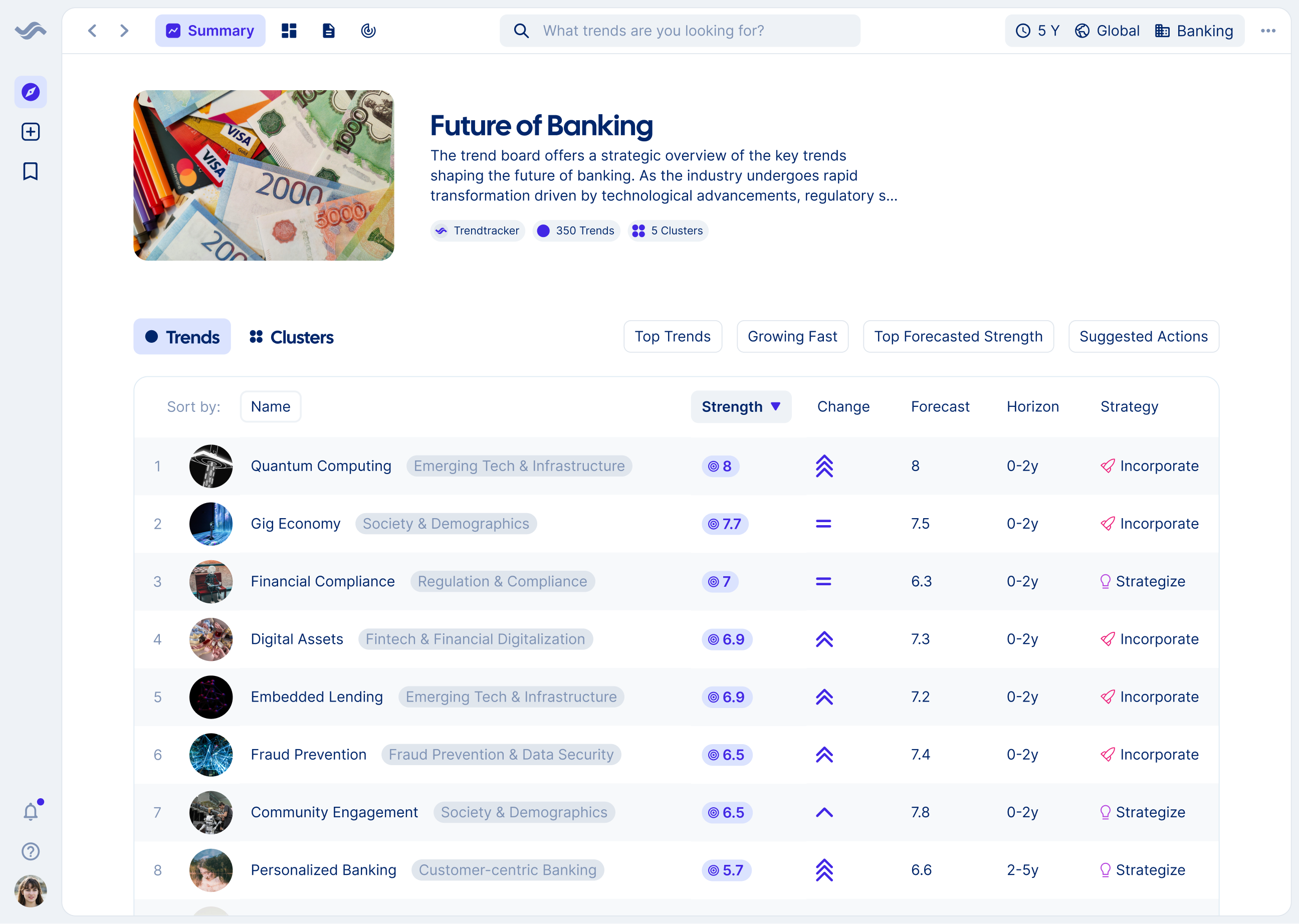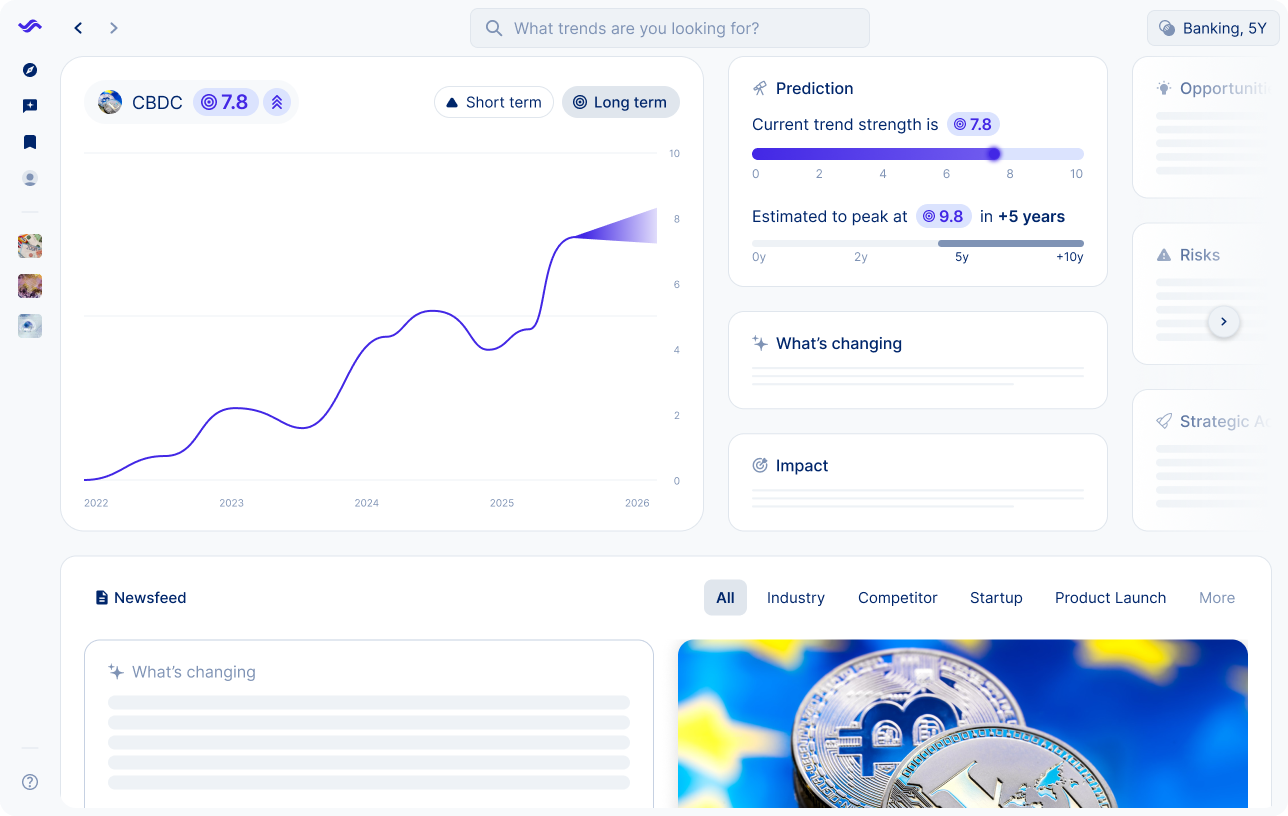

Problems
Our solution





See your global banking landscape clearly
AI Analyst for banking leaders
A common intelligence layer for the bank
Track trends in real time
Key benefits
Most strategists say they finally stopped drowning in global data, thanks to Trendtracker’s instant, AI-powered insights.
Trends in the industry


Central banks worldwide are piloting digital currencies to improve cross border payments and strengthen financial inclusion. Countries in Europe and Asia are advancing large scale trials, though challenges around adoption, costs and regulation remain.
CBDCs are reshaping the foundations of banking. They can streamline payments and reduce reliance on traditional intermediaries, but also raise questions about profitability, compliance and customer trust. Banks need to adapt quickly to remain competitive as regulators push forward.
Financial institutions should invest in digital infrastructure to integrate CBDCs into existing systems, build strong partnerships with fintechs and regulators, and develop secure wallets for customers. Success will depend on aligning compliance, cybersecurity and innovation to deliver trust and efficiency.


Banks are adopting AI and advanced analytics to combat fraud in real time, securing digital transactions and protecting customer trust. New regulations and technologies are reshaping the way institutions manage risks as digital banking and online payments expand rapidly.
Fraud prevention is now central to both profitability and resilience. Stronger safeguards reduce financial losses and operational risks, while also reinforcing regulatory compliance and customer confidence. Institutions that fall behind risk greater exposure and reputational damage.
Banks should invest in AI driven fraud detection, expand partnerships for data sharing, and strengthen customer verification systems.


Banks are expanding green bonds, ESG linked loans and carbon credit markets as demand for sustainable investment grows. Strong investor appetite and regulatory pressure are pushing sustainable finance from niche products into the mainstream.
Sustainable finance is becoming central to banking strategies, shaping lending, investment portfolios and compliance frameworks. Institutions that embrace it gain access to new revenue streams and strengthen their reputation with regulators, investors and customers.
Banks can expand ESG aligned products, integrate transparency into reporting, and use digital tools like blockchain to strengthen trust. Building clear frameworks for sustainable finance will allow institutions to balance profitability with long term resilience.
Want to discover, analyse and forecast banking trends on autopilot? See how Trendtracker’s AI turns information overload into instant, actionable clarity for banking strategists.
The banking industry is under pressure to evolve faster than ever. Rising regulatory demands, digital competition, and shifting customer expectations are reshaping how banks operate, build trust, and grow. At the same time, new technologies and sustainability imperatives are opening opportunities for banks to redefine their role in society. The sector’s resilience will depend on how quickly it adapts its models while balancing profitability with transparency and purpose.
Money itself is being reinvented. From central bank digital currencies to tokenized assets, banks are being challenged to adapt to new forms of value exchange. The institutions that lead in integrating digital currencies and next-generation payments will define the future of financial infrastructure.
Today’s landscape
Over 100 countries are exploring CBDCs, with pilot projects already underway in Europe and Asia. The goal is faster, cheaper, and more transparent cross-border payments. Yet questions remain about privacy, interoperability, and how CBDCs will coexist with commercial banks.
The road ahead
CBDCs could redefine the role of banks, making them intermediaries in a new kind of public-private monetary ecosystem. The pace of regulatory frameworks will determine how fast adoption scales.
PESTLE: Political/Legal (P/L), Technological (Tech), Economic (Econ)
Horizon: Mid-term (5–10y)
Strategic action: Banks should test integration models for CBDCs, strengthen dialogue with regulators, and design customer-facing solutions that build trust in digital money.
Today’s landscape
Securities, bonds, and even real estate are being tokenized on blockchain platforms. This is allowing faster settlement, greater transparency, and new investment models. Large banks are already experimenting with tokenization platforms to keep pace.
The road ahead
Tokenization could unlock trillions in illiquid assets and reduce market friction. Standardization and global regulation will be critical for mainstream adoption.
PESTLE: Technological (Tech), Economic (Econ), Political/Legal (P/L)
Horizon: Mid- to long-term (5–15y)
Strategic action: Develop tokenization pilots with institutional investors, while preparing compliance frameworks to navigate fragmented regulations.
Today’s landscape
Customers and businesses demand instant settlement. Banks are under pressure from fintechs and Big Tech firms offering faster, cheaper services. Cross-border payment systems like SWIFT gpi and ISO 20022 are laying the foundation.
The road ahead
Expect a race to deliver frictionless, real-time international payments. Banks that cannot compete risk disintermediation by more agile players.
PESTLE: Economic (Econ), Technological (Tech), Social (S)
Horizon: Near-term (0–3y)
Strategic action: Upgrade core infrastructure to support real-time rails, and build partnerships with fintechs to keep customers in the banking ecosystem.



Trust remains the currency of banking. With cyber threats, fraud, and regulatory scrutiny rising, security and compliance are becoming as important as profitability. Banks that lead in protecting customers and ensuring transparency will secure long-term resilience.
Today’s landscape
AI and machine learning are being deployed to detect suspicious transactions in real time. Fraudulent activity is growing more sophisticated, putting pressure on banks to invest in cutting-edge defenses.
The road ahead
Fraud prevention will increasingly rely on collaborative intelligence, where data is shared across institutions to improve detection. Regulators are likely to mandate stronger safeguards.
PESTLE: Technological (Tech), Political/Legal (P/L), Social (S)
Horizon: Near- to mid-term (0–5y)
Strategic action: Scale AI-driven fraud detection tools, build industry-wide data-sharing partnerships, and enhance customer verification systems.
Today’s landscape
Banks are testing AI models to streamline compliance tasks, from anti-money laundering (AML) monitoring to stress testing portfolios. Efficiency gains are evident, but regulators are cautious about transparency and fairness.
The road ahead
Expect wider adoption of AI in regulatory compliance, with increasing demand for explainable and auditable models. This could reshape staffing and workflows across risk functions.
PESTLE: Technological (Tech), Political/Legal (P/L), Economic (Econ)
Horizon: Mid-term (5–10y)
Strategic action: Invest in explainable AI tools and work closely with regulators to establish trust. Position AI as a compliance enabler rather than a cost-cutting tool.
Today’s landscape
Cyberattacks on financial institutions are becoming more frequent and costly. Banks are moving from reactive defenses to embedding cybersecurity into strategic planning.
The road ahead
Cybersecurity will become a board-level issue, influencing customer trust and regulatory approval. Institutions will compete on security as much as on products.
PESTLE: Technological (Tech), Political/Legal (P/L), Social (S)
Horizon: Near-term (0–3y)
Strategic action: Elevate cybersecurity to a strategic priority, with board oversight and continuous investment in next-generation defenses.

Sustainability is no longer optional. Investors, regulators, and customers are pushing banks to take responsibility for the climate and social impact of their portfolios. This is reshaping capital flows, lending policies, and the competitive landscape.
Today’s landscape
Green bonds and ESG-linked loans are growing quickly, with banks under pressure to prove the credibility of their sustainability claims. Regulators are tightening disclosure requirements.
The road ahead
Sustainable finance will become mainstream, with access to capital increasingly tied to ESG performance. Banks unable to adapt may face stranded assets and reputational risks.
PESTLE: Environmental (Env), Political/Legal (P/L), Economic (Econ)
Horizon: Mid-term (5–10y)
Strategic action: Integrate ESG into lending and investment decisions, and ensure transparent reporting frameworks to maintain credibility.
Today’s landscape
Central banks are mandating climate stress tests to measure how resilient financial institutions are to physical and transition risks. This is reshaping risk models.
The road ahead
Climate risk will be integrated into every major banking decision. Institutions that adapt early will be more resilient and better positioned with regulators.
PESTLE: Environmental (Env), Political/Legal (P/L), Economic (Econ)
Horizon: Near- to mid-term (0–5y)
Strategic action: Develop robust climate-risk models and embed them into enterprise risk management.
Today’s landscape
Digital banking services are expanding access to underserved populations, particularly in emerging markets. This aligns with ESG goals while opening new growth markets.
The road ahead
Financial inclusion will be both a growth opportunity and a reputational imperative. Regulators and investors will continue to reward institutions that prioritize inclusion.
PESTLE: Social (S), Technological (Tech), Economic (Econ)
Horizon: Near- to mid-term (0–5y)
Strategic action: Expand digital-first banking models and partnerships with fintechs to reach underserved communities.
